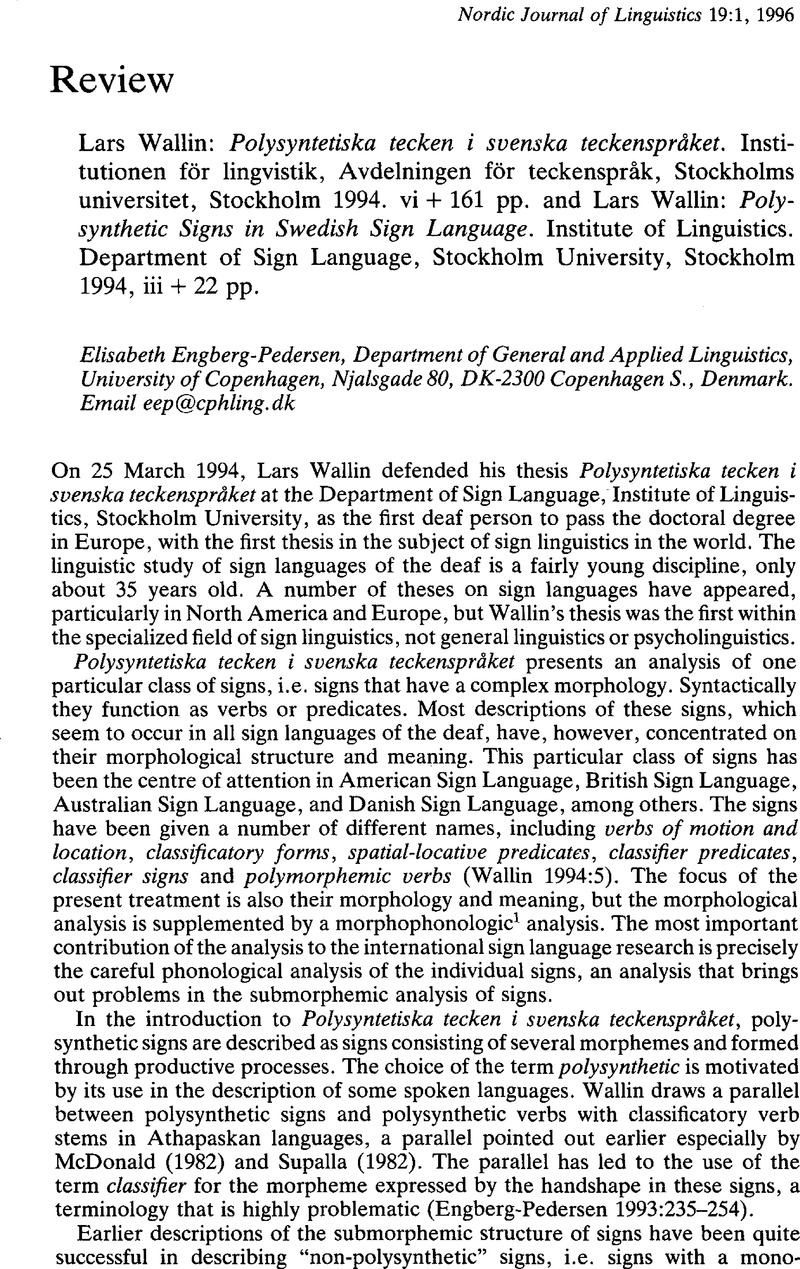No CrossRef data available.
Article contents
Lars Wallin: Polysyntetiska tecken i svenska teckenspråket. Institutionen för lingvistik, Avdelningen för teckenspråk, Stockholms universitet, Stockholm1994. vi + 161 pp. - Lars Wallin: Polysynthetic Signs in Swedish Sign Language. Institute of Linguistics. Department of Sign Language, Stockholm University, Stockholm1994, iii + 22 pp.
Published online by Cambridge University Press: 22 December 2008
Abstract
An abstract is not available for this content so a preview has been provided. Please use the Get access link above for information on how to access this content.

- Type
- Review
- Information
- Copyright
- Copyright © Cambridge University Press 1996
References
REFERENCES
Bergman, B. 1977. Tecknad svenska. Lund: Liber Läromedel. (English translation. 1979. Signed Swedish. Stockholm: National Swedish Board of Education.)Google Scholar
Engberg-Pedersen, E. 1993. Space in Danish Sign Language: The Semantics and Morphosyntax of the Use of Space in a Visual Language. Hamburg: Signum Press.Google Scholar
Liddell, S. K. 1984. THINK and BELIEVE: Sequentiality in American Sign Language. Language 60(2), 372–399.CrossRefGoogle Scholar
Liddell, S. K. & Johnson, R. E. 1989. ASL: The Phonological Base. Sign Language Studies 64, 195–277.CrossRefGoogle Scholar
McDonald, B. H. 1982. Aspects of the American Sign Language predicate system. Ph.D. Dissertation, University of Buffalo.Google Scholar
Newport, E. L. 1982. Task Specificity in Language Learning? Evidence from Speech Perception and American Sign Language. In Wanner, E. & Gleitman, L. R. (eds), Language Acquisition: The State of the Art. Cambridge: Cambridge University Press, 450–486.Google Scholar
Stokoe, W. C. 1978. Sign Language Structure: The First Linguistic Analysis of American Sign Language. Second edition. Silver Spring, Maryland: Linstok Press.Google Scholar
Supalla, T. 1982. Structure and Acquisition of Verbs of Motion and Location in American Sign Language. Ph.D. dissertation, University of California, San Diego.Google Scholar
Supalla, T. 1986. The Classifier System in American Sign Language. In Craig, C. (ed.), Noun Classes and Categorization: Proceedings of a Symposium on Categorization and Noun Classification (Eugene, Oregon, October 1983). Amsterdam: John Benjamins, 181–214.Google Scholar
Talmy, L. 1975. Semantics and Syntax of Motion. In Kimball, J. P. (ed.), Syntax and Semantics, Vol. 4. New York: Academic Press, 181–238.CrossRefGoogle Scholar
Talmy, L. 1985. Lexicalization Patterns: Semantic Structure in Lexical Forms. In Shopen, T. (ed.), Language Typology and Syntactic Description, Vol. III: Grammatical Categories and the Lexicon. Cambridge: Cambridge University Press, 57–149.Google Scholar




